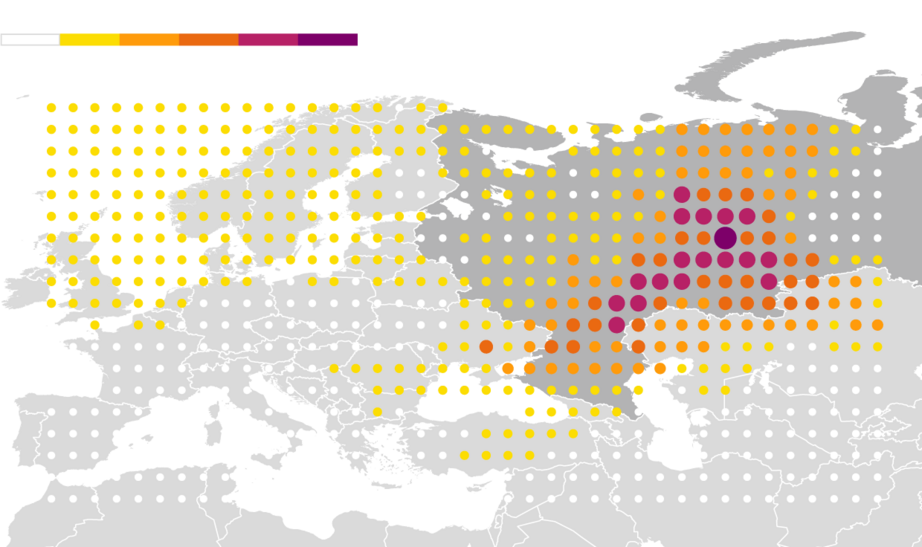Russian nuclear facility denies it is source of high radioactivity levels
Greenpeace calls for investigation after levels of ruthenium-106 in atmosphere near Urals site found to be 986 times norm
Nuclear experts have said there was no evidence to suggest the leak posed a significant hazard to human health or the environment.
A secretive Russian nuclear facility has denied it was behind high atmospheric concentrations of the radioactive isotope ruthenium-106, after Russia’s meteorological service confirmed levels several hundred times the norm were found in several locations in the country during tests in late September.
Greenpeace has called for an investigation into a potential cover-up of a nuclear accident after Russia’s nuclear agency had denied European reports of increased ruthenium-106 levels. Rosgidromet, the weather monitoring service, released test data on Monday that showed levels were indeed much higher than normal. The most potent site was Argayash in the south Urals, where levels were 986 times the norm.
Argayash is about 20 miles from Mayak, a facility that reprocesses spent nuclear fuel. The plant facility issued a denial on Tuesday. “The contamination of the atmosphere with ruthenium-106 isotope registered by Rosgidromet is not linked to the activity of Mayak,” a statement said.
It went on to reassure people that the measurements were well below dangerous levels: “The measurements which Rosgidromet has released suggest that the dose people might have received is 20,000 times less than the allowed annual dose and presents no threat at all to health.”
Nuclear experts also said there was no evidence to suggest the leak posed a significant hazard to human health or the environment.
A report earlier this month from France’s Institute for Radioprotection and Nuclear Safety (IRSN) said ruthenium-106 had been detected in France between 27 September and 13 October.
In mid-October, the state nuclear agency Rosatom issued a statement saying that samples from across Russia during the same period showed no trace of ruthenium-106 after European agencies had reported levels that were higher than usual.
Where did the radiation leak originate?
The IRSN, France's public authority on nuclear radiation risks, has produced a map showing the probable location of the release

Greenpeace Russia called on Rosatom to open “an in-depth inquiry and publish the results about the incidents at Mayak”, and the group also said it would ask prosecutors to look into the potential concealment of a nuclear incident.
Neil Hyatt, professor of nuclear materials chemistry at the University of Sheffield, said: “This isotope comes from recycling of nuclear fuel or medical isotope targets. It’s quite short-lived so that means it must be relatively young fuel. It must have come out of a reactor recently and been reprocessed recently.”
Russian radiation leak: everything you need to know
Ilya Yarmoshenko, a scientist, told a Russian news agency that the high levels of ruthenium-106 were harmless, and levels 10 times higher of other radioactive substances could be found inside normal homes. He said there was no need to evacuate any of the residents of the affected areas but added that the most important thing now was to identify the source of the radiation.
Hyatt agreed: “It’s certainly not a major health concern based on what we know at the moment. If it’s concentrated you would certainly want to limit access to that area. If it’s not ingested then the hazard is going to be lower.”
Prof Paddy Reagan, a nuclear expert at the University of Surrey, said: “When they say this was 900 times the background level it’s a surprising number, but the background level is basically zero. I don’t think there’s any radiological danger from it.
“The measurement of this highlights how sensitive radiation detectors are. It’s basically impossible to hide a leak. If it was a weapon explosion or a reactor leak there’d be other radioisotopes, so it looks like a leak from waste reprocessing.”
Earlier this year the Mayak facility began receiving shipments of spent fuel from decommissioned nuclear submarines in the Arctic. Photograph: STR/AP
Hyatt said that it was unusual that other radioisotopes had not been detected as normally waste fuel would contain a mix of different nuclear materials. One possibility is that the fuel was being processed and concentrated for use in nuclear batteries, which are used in satellites.
“If the plant that’s making those has sprung a leak it might explain why they’ve detected that and nothing else,” he said.
Evgeny Savchenko, the top health and safety official in Chelyabinsk region, where the Mayak facility is located, dismissed health fears as “hysteria” and said the fact that the information came from abroad was suspicious, noting that France also has a nuclear fuel processing site “that competes with our Mayak”.
Savchenko said there was absolutely no reason for the population to fear health effects. “Note that officials and their families don’t have injections against radiation ... so you’d have to be a total fool to hide dangerous information and not take steps to save people,” he said.
In 1957 Mayak was the site of one of the worst nuclear disasters in history, which at the time was covered up by the Soviet regime. Earlier this year shipments of spent nuclear submarine fuel that had been left at an Arctic naval base since the Soviet period began to be shipped to Mayak, where it will be reprocessed and repurposed for use in civilian nuclear reactors. Much of the plant’s operations remain shrouded in secrecy.
For the rest of this article please go to source link below.
